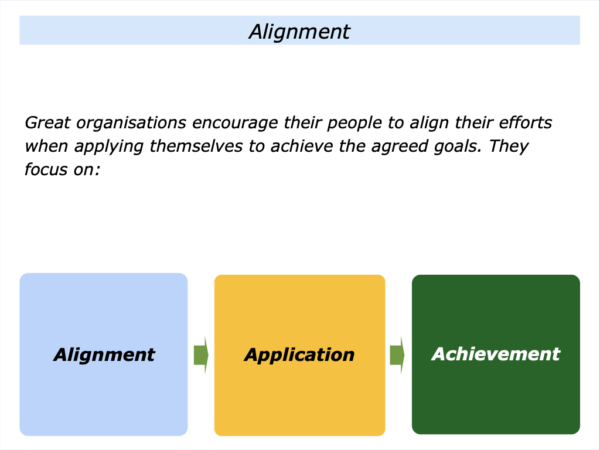
Great organisations encourage their people to align their efforts when applying themselves to achieve the agreed goals. Different organisations do this in different ways.
One approach is to encourage people to focus on the organisation’s purpose and follow its principles. Applying themselves in this way will often achieve at least 8/10.
There may be times, however, when they will want people to be agile – within certain parameters. People may then do what is necessary and produce something special to achieve the picture of success. Let’s explore these themes.
This approach can help people to go through what some call the team stages of Forming, Norming and Performing. There is no need for the Storming stage. Let’s explore how to encourage people to align their efforts to achieve the team’s goals.
Alignment
Imagine that you lead an organisation and want to encourage people to align their contributions with the organisation’s aims. Different organisation do this in different ways. Some are more effective than others. You will, of course, choose your own approach.
Some organisations try to
order their people to be aligned
They issue orders from the top and expect their people to fall into line. This approach may work for a time but then some people may decide they want more autonomy and move on from the organisation.
Some organisations try to control and
micromanage their people into being aligned
They order people to follow certain processes and do certain tasks. They micromanage their people to ensure they are doing things in a certain way. This can give the impression of alignment but it can also drive some people away from the organisation.
Some organisations try persuade
their people to be aligned
They may aim to sell a vision to their people. Sometimes this can work when there is a compelling story and people buy into following the strategies. Some people may prefer to be the ones who persuade themselves, however, rather being sold something.
Some organisations try to communicate a purpose, principles
and picture of success that can help to create alignment
They communicate these to their people. They then invite people to decide if they want to contribute. This approach can work providing the organisation shows it is serious and encourages people to use their strengths to achieve the picture of success.
Some organisations try to recruit people who want to
follow certain principles and this helps to create alignment
They communicate their purpose, principles and picture of success. They then recruit people who want to follow these principles and achieve the goals. This ensures there is an ongoing stream of people who want to use their strengths to help the organisation to achieve success.
Imagine that you have pursued a particular approach to creating alignment. This may have included aiming:
To communicate the organisation’s purpose, principles and picture of success;
To communicate that you would like each team and each person to clarify their contributions to following their principles and achieving the picture of success;
To communicate that you will then create success stories that show how the teams and people are following the principles and contributing towards achieving the picture of success.
You will, of course, also give people the opportunity to decide if they do want to take these steps. If so, you will make clear contracts with them about the outcomes they will deliver towards achieving the goals.
One leader I mentored aimed to take this approach. This would also involve meeting with each of their leadership team members. Bearing this in mind, he asked the following questions.
“How can I make sure the individuals are really aligned? How can I make sure they really want to take a specific role in the leadership team? They may say they are aligned but their later actions my prove otherwise.”
Bearing this in mind, we explored one approach to trying to increase the chances of individuals being aligned with the principles and picture of success.
Clarifying Whether A Person Wants To
Align Their Efforts To Achieve The Goals
Imagine that you are going to meet a member of your leadership team. You may want them to make a specific contribution to helping towards achieving the team’s goals. This will involve them delivering certain results in a particular role. How to take this step? You may want to explore the following themes before and then during the meeting.
Before The Meeting
It can be useful to work through the following theme before meeting the person. You can aim:
To clarify the specific results the person will need to deliver in a particular role – the picture of success;
To clarify whether you think the person is prepared to follow the organisation’s principles and deliver the picture of success;
To clarify whether – bearing in mind their long-term career goals – the person will be prepared to make this particular contribution towards achieving the picture of success.
This final point is crucial. The person may be a good professional and do a good job. But it can be good to check their motivation level.
Imagine the person will be able to see how the role may fit in terms of working towards their long-term career goals. They will then be more likely to align their efforts towards achieving the organisation’s aspirations.
During The Meeting
If appropriate, you can then have a conversation with the person around the following themes. This sounds rather formal but you can cover these in your own way.
The Picture Of Success
“I would like to talk with you about how you can build on your strengths and make your best contribution to the organisation. There is a particular role on offer but it would be good to explore whether this would fit for you. I would like us to try to find a win-win that would also help you to work towards your long-term career goals.
“Looking at the particular role, these are the results that a person in this role would need to deliver. They would need:
1) To …
2) To …
3) To …
The Principles
“As you know, the principles want to follow in organisation to achieve the results are these:
1) To …
2) To …
3) To …
“Looking ahead, think about if you would be prepared to follow these principles to deliver the results.
“You will do this by using your strengths, of course, and doing this in your own way. We want characters not clones. But it is important that people across the organisation keep focusing on following the principles.”
The Professional Contribution
“Bearing these things in mind, you may want to take time to reflect. Take time to think about if you would like to take the role and deliver these results.
“It is also good if you can see how taking this role may help you to work towards your long-term career goals.
“You have strengths in certain areas but not necessarily in others. Bearing this in mind, we will encourage you to build on these strengths.
“If appropriate, we can get somebody who has complementary strengths to work alongside you to cover the other areas.
“At the same time, you will of course still be accountable for ensuring the overall results are delivered.
“Take time to think and let me know if you would like to take the role. If not, we can look at other ways you may be able to contribute towards achieving the picture of success.”
You will cover such areas in your own way. The keys will be to focus on the following themes:
To clarify the results to be delivered in a particular role and how these will contribute towards achieving the picture of success;
To clarify whether the person would like to deliver those results and contribute towards achieving the picture of success;
To then make clear contracts about the person’s contribution towards achieving the picture of success.
Let’s assume that you have taken these steps. Each team and each individual has clarified the contribution they want to make towards achieving the organisation’s picture of success. It will then be time to move onto the next stage.
Application
Imagine that you lead an organisation. People have made clear contracts about the contributions they want to make. How can you know if they are really aligned in working towards the goals?
The answer will be if they apply
themselves to achieving the aims.
Different organisations choose different ways to clarify whether people are translating their commitments into action. The approaches they use can have both pluses and minuses.
Some organisations aim to police people’s actions. They produce lists of tasks and then micromanage people into doing these tasks. This approach can work for a short while but it also has downsides.
Some organisations choose another way. They encourage their people to keep following the principles. This involves taking the following steps.
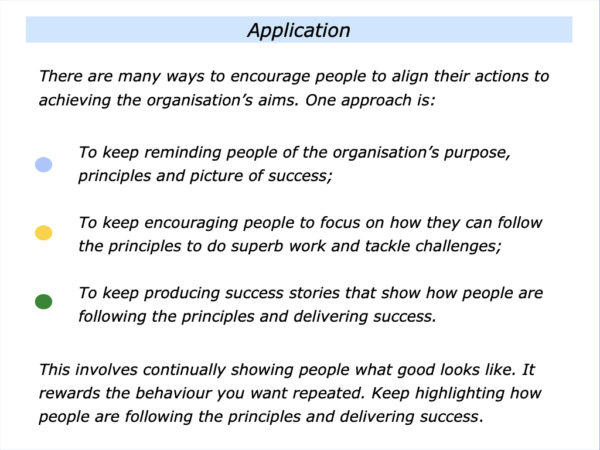
This approach often works. You can then keep encouraging people to follow the principles and achieve success.
Imagine, however, that positive majority of people are taking this approach but one person is causing problems. They are choosing to behave in ways that are unprofessional or causing collateral damage.
You can then meet with the person and clarify whether they want to follow the principles. One approach is to focus on the big picture and invite them to decide if they want to contribute.
You will do this in your own way. When having the conversation, however, you may want to cover the following points.
“Thank you for meeting. This may be a difficult conversation but I am sure that we can do our best to find a solution. Let’s go back to the big picture about what we are trying to do in our work.
The purpose of our organisation is:
* To …
The principles we want to follow to achieve this
purpose – together for the reasons for these – are:
* To …
* To …
* To …
“Bearing these things in mind, I would like you to take time to reflect and decide if you want to follow these principles and contribute towards achieving the goals.
“If so, then I would like you to come up with a plan of how you can do this and contribute towards achieving the goals. If not, then we can look at other options.”
This may sound like a tough approach but you are the custodian of the culture. Your aim is to ensure that people are following the principles towards achieving the goals.
Imagine that you are going to have such a conversation with somebody. It can be useful to take the following approach:
To focus on alignment by inviting the person to decide if they want to follow the principles;
To not get into arguments – if the person wants to argue you don’t fall into that trap;
To keep returning to explaining the principles and inviting the person to decide if they want to follow them.
Imagine the person says they do. You can invite them to produce an action plan about how they aim to the principles in the next month. They need to take this step rather than you write a plan or police them.
Imagine the person says they don’t want to or, after saying they do, they break the agreements. You then replace them with people who do want to follow the principles.
Let’s assume that many people are aiming to translate the principles into action. You will then move on to the next stage.
Achievement
Imagine that people are aligning their efforts. You will probably have some mechanism for clarifying the progress that they are making.
As mentioned elsewhere in the book, you may encourage people to keep others informed about their progress. Bearing in mind their agreed goals, they may give monthly updates on:
The specific things they have delivered in the past month;
The specific things they aim to deliver in the next month;
The challenges they face and any support they may need to tackle these challenges;
The other topics they may wish to discuss.
You may also want to ensure that people throughout the organisation keep focusing on the big picture. If appropriate, you can give them regular updates regarding how they are aligning their efforts towards achieving the organisation’s aims.
Different leaders do this in different ways. One approach is to start by reminding people of the organisation’s purpose, principles and picture of success. You can then focus on the following themes.
Achievements
You can describe the specific things that people have achieved during a certain time frame. You can bring these to life by describing specific examples, customer feedback or other achievements.
Aims For The Future
You can describe the specific aims for the future. These can include the plans: a) for building on what the organisation does well; b) for tackling areas for improvement; c) for working towards other specific goals.
Additional Things
You can describe any additional things. These may include stories about employees achieving things outside work, proposed wellbeing initiatives or any other topics that may be of interest.
You will, of course, do this in your own way. If appropriate, however, you may wish to use the following template.
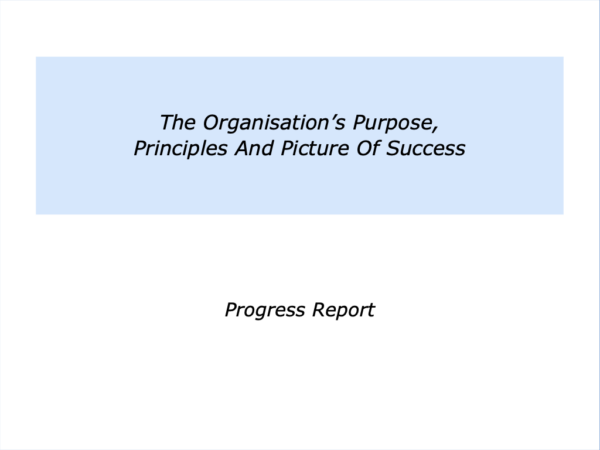
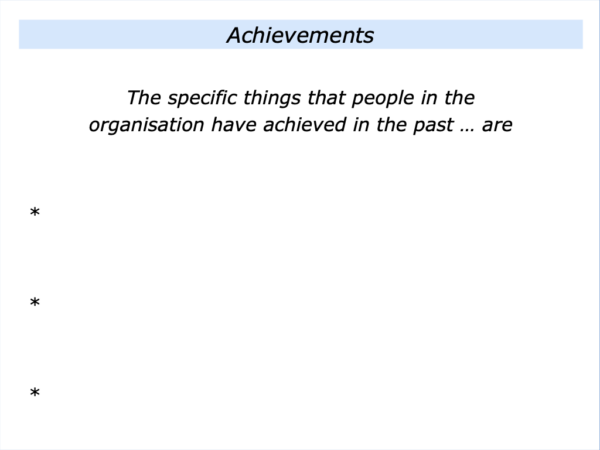
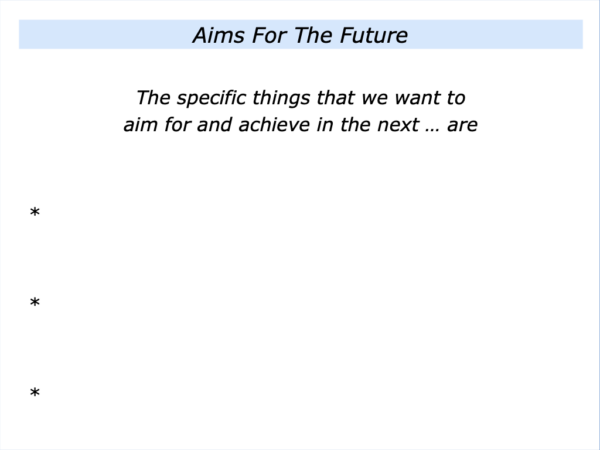
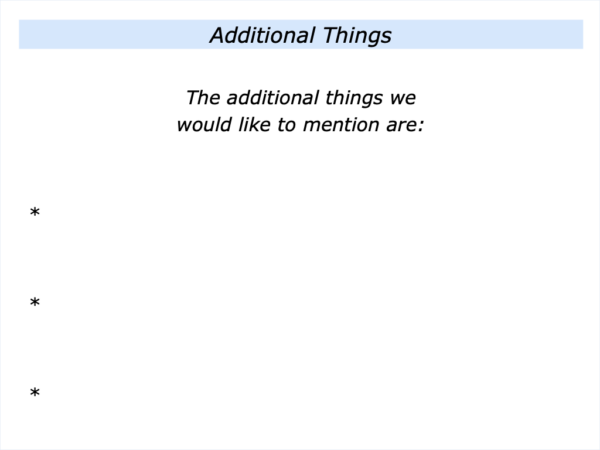
Application Sometimes Also Needs Agility
Great organisations encourage people to align their efforts when working towards the agreed goals. As mentioned earlier, however, they also give them the following message:
We want you to keep following the principles. There may be times when you need to be agile in the way you express these, however, in order to achieve the picture of success.
Let’s return to your own work. Imagine that you want to do your best to create alignment when leading a project group, team or organisation. One approach is to take the following steps. You can aim:
To give people the big picture by communicating the purpose, principles and picture of success;
To build on the people who want to follow the principles and make clear contracts about their contributions to achieving the picture of success;
To enable people to follow the principles and do superb work on the way towards achieving the picture of success.
Looking ahead, can you think of a situation where you may want to follow elements of the alignment approach? How can you do this in your own way?
If you wish, try tackling the exercise on this theme. This invites you to complete the following sentences.
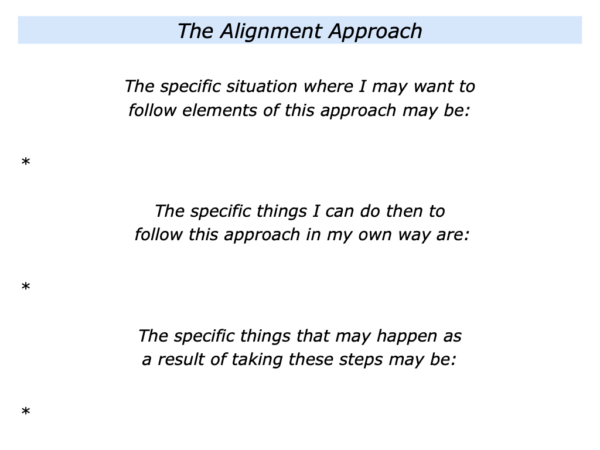






Leave a Reply